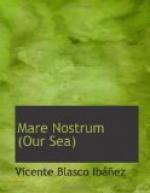The ships at the docks seemed to be increasing in size, for on arrival they had extended only a few yards above the wharf; but now that their cargo was piled up on land, they appeared like towering fortresses. Two-thirds of the hull, usually hidden in the water, were now in evidence, showing the bright red of their curved shell. Only the keel kept itself in the water. The upper third, that which remained visible above the line of flotation in ordinary times, was now a simple black cornice that capped the long purple walls. The masts and smokestacks diminished by this transformation appeared to belong to other smaller boats.
Each of these merchant and peaceful steamers carried a quickfirer at the stern in order to protect itself from the submarine corsairs. England and France had mobilized their tramp ships and were beginning to supply them with means of defense. Some of them had not been able to mount their cannon upon a fixed gun carriage, and so carried a field gun with its mouth sticking out between the wheels bolted to the deck.
The captain in all his strolls invariably felt attracted by the famous Cannebiere, that engulfing roadway which sucks in the entire activity of Marseilles.
Some days a fresh and violent wind would eddy through, littering it with dust and papers, and the waiters of the cafes would have to furl the great awnings as though they were the sails of a vessel. The Mistral was approaching and every owner of an establishment was ordering this maneuver in order to withstand the icy hurricane that overturns tables, snatches away chairs, and carries off everything which is not secured with marine cables.
To Ferragut this famous avenue of Marseilles was a reminder of the antechamber of Salonica. The same types from the army of the East crowded its sidewalks,—English dressed in khaki, Canadians and Australians in hats with up-turned brims, tall, slender Hindoos with coppery complexion and thick fan-shaped beards, Senegalese sharpshooters of a glistening black, and Anammite marksmen with round yellow countenance and eyes forming a triangle. There was a continual procession of dark trucks driven by soldiers, automobiles full of officers, droves of mules coming from Spain that were going to be shipped to the Orient, leaving behind their quick-trotting hoofs a pungent and penetrating smell of the stable.
The old harbor attracted Ferragut because of its antiquity which was almost as remote as that of the first Mediterranean navigations. On passing before the Palace of the Bourse he shot a glance at the statue of the two great Marseillaise navigators,—Eutymenes and Pytas,—the most remote ancestors of Mediterranean navigators. One had explored the coast of Senegambia, the other had gone further up to Ireland and the Orkney Islands.




